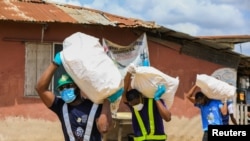The United Nations' food chief warned Tuesday that while the world fights the coronavirus pandemic, it is also on the brink of a hunger pandemic.
"Millions of civilians living in conflict-scarred nations, including many women and children, face being pushed to the brink of starvation, with the specter of famine a very real and dangerous possibility," World Food Program Executive Director David Beasley told a remote meeting of the U.N. Security Council.
Beasley said 821 million people worldwide are chronically hungry, and 135 million face crisis levels of hunger. With the added stress of COVID-19, an additional 130 million people could be pushed to the brink of starvation by the end of 2020.
"In a worst-case scenario, we could be looking at famine in about three dozen countries," he warned.
In a report released Tuesday by the Global Network Against Food Crises, a coalition of U.N., governmental and non-governmental agencies, it attributed the hunger increase to economic shocks, conflicts, drought and other weather-related events.
Declines in economic activity and trade restrictions "are likely to diminish national budgets, reduce household incomes and may lead to rises in food prices," the network said.
The report warned that "critical food value chains" could be disrupted, particularly in "under-resourced and vulnerable nations" such as South Sudan, Yemen and Afghanistan.
Over half of the 135 million people covered in the report live in Africa, 43 million reside in Asia and the Middle East, and more than 18 million live in Latin America and the Caribbean.
"There are no famines yet," the WFP chief said. "But I must warn you that if we don't prepare and act now to secure access, avoid funding shortfalls and disruptions to trade, we could be facing multiple famines of biblical proportions within a short, few months."
The Global Network report also said many "high-income nations" may "find it increasingly difficult" to help address the global food crisis "when the social and economic situations in their own countries are also greatly affected."
The WFP's Beasley echoed this concern, worrying that when donor countries' revenues are down, it could negatively impact lifesaving foreign aid.
The coronavirus outbreak first hit some of the world's largest economies. After originating in China, Italy and Spain were particularly hard hit. The U.S. now leads the world in the number of people who have contracted COVID-19 and those who have died from the disease.










